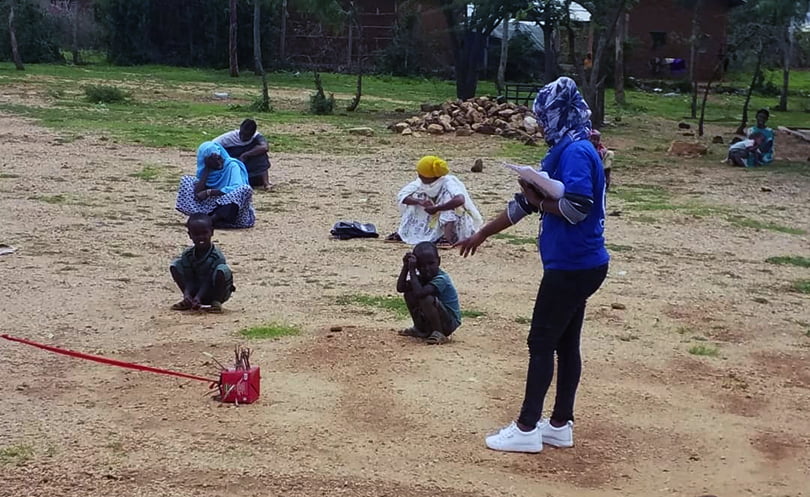Those affected are mainly adults, especially the elderly. So, most of the information and literature about how to prevent the disease from spreading has been itself spread via radio, mounted speakers, and hundreds of door to door hygiene prevention campaigns that are designed for the old. Same with awareness raising activities that explain methods of how to stop the deadly disease.
What about children and the young? Was there was a gap in reaching out to them?
With this question in mind, IOM Ethiopia set out to educating children, society’s most vulnerable, on how to protect themselves from COVID-19. The approach combined both an age old, and modern approach, both designed to have fun: puppetry and animation.
IOM staff use puppets and animation picture cards to teach children about how to protect themselves from COVID-19. During a performance, puppets ‘talk’ about COVID-19 and ‘ask’ questions of the watching children. The children answer, and a puppet responds with information about how the children can face disease.
“By using objects like puppets or images instead of simply talking about the virus, children become more engaged and they understand better. Demonstrating to children in a practical way makes it easier and quicker for them to understand ideas. We also use exercises, like practicing avoiding bodily contact, and showing the children physical distancing,” says Rosa Girma, IOM Hygiene Promotion Clerk in Dire Dawa. “The children are so fascinated and actively participate when we approach them this way.”

A puppetry demonstration for children in Bule Hora when COVID-19 was just emerging in Ethiopia, April 2020. IOM Ethiopia
So far, the performances have been conducted in Dire Dawa, East Hararghe, and Bule Hora. Children in these communities are most in need of information about COVID-19 as their families were displaced from their homes by violent conflict. The families in East Hararghe zone are living in camps for internally displaced persons (IDPs), while those in the Bule Hora zone have returned home, having previously fled violence.
Sessions take place in small groups of 4 to 8 children, who are instructed to wash their hands at the beginning and end of each session, and to do this regularly. The IOM team also demonstrates to the children how to maintain physical distancing, as one way of stopping COVID-19.
Through these activities, information about coronavirus is being shared with children more effectively. Besides keeping the young people active, this is particularly important at this time because all schools and playgrounds in Ethiopia are closed to try to prevent the spread of the disease.

Cover of the English version of the COVID-19 coloring book. IOM Ethiopia
IOM Ethiopia also recently developed an animation coloring book for children that teaches the young about COVID-19 in a fun and absorbing way. The book tells the story of an Ethiopian child who tries to make sense of the world changed by COVID-19 through a series of questions about the disease she asks a family member. The cartoon picture books have captions printed in Amharic, Oromiffa, Somali and English.






